






It is my pleasure to welcome you to the American School of Madrid and more specifically, the Lower School
Our division is made up of over 400 students who span in age from 3 to 11 years old We have students from around the world and students who have attended ASM for many years. Together, the Lower School students take care of each other, their school, and their community Our school is a place where children make lifelong friends, work to solve problems and can be creative. The four pillars of our mission statement help to guide our work and our community
In addition, the Lower School strives to ensure children experience childhood Through our OPAL (Outdoor Play and Learning) program, our students have opportunities to freely design their own play experiences
More information about what you can expect this year for your Grade 2 learner can be found in this grade level guide. Additionally, please be sure to review and continue to reference our Lower School Learning Program Site, located on the ASM website. There you will find all of the details and information about our school procedures and policies.
Of course, if you have any questions, please feel free to contact your child’s teachers or the Lower School Office. We are here to help you.
I wish you and your child a wonderful year in Grade 2!
Warmly,
Jen Munnerlyn Lower School Director
2024-25 Homeroom Teachers and Teaching and Learning Assistants
2C- Dez Carter
2B- Elizabeth Buchsteiner
2P- Noelle Primeaux
2CA- Cristina Castillo
G2 Teaching and Learning Assistants: Denise Jackson/ Emily Gansel (Paola de Valdenebro)
Specialist Teachers
Music- Jonathan Hunt/ Rory Reagan
Art- Elisa Sobelman/ Linda Phillips
PE- Daniel Martinez/ Jaime Sportun
Specials Teaching and Learning Assistant: Emily Murphy
Spanish Teachers
Lucia Hernanz, Katia Reyes, Feli Lopez, Iciar Olazabel, Daniella Carrillo, Juan Carlos Gallardo, Mamen Pretel, Mercedes Marine
Coordination of Support Team
Counselor- Melissa Marsh
Learning Support Teachers- Margaret LeGrand, Meredith Bosco, Richard Marshall, Katrina Bruening, Camila Reina
COST Teaching and Learning Assistants: Toni Jimena-Fragoso and Taylor McGilbra
Mission statement
At the American School of Madrid, we empower lifelong learners to take on challenges and thrive, care for others in our diverse international community, and think globally and creatively toward a better future.

At the American School of Madrid, we believe Important Learning
● Should be purposeful and relevant.
● Involves real-world experiences, risk and failure, self-reflection, and choice.
● Is a continuous process.
● Requires pushing through challenges and perceived limits.
● Is facilitated by skillful, caring teachers.
● Requires students to actively own their own learning.
● Takes place within a positive, supportive school community
● Is supported by perseverance, problem-solving, self-reflection, time management, empathy, and collaboration.
● Requires creativity by teachers and students.
We, at the American School of Madrid, stand for the rights of every individual to safety, belonging, and freedom from discrimination
We as teachers, students, parents, administrators, staff, and board members hold ourselves accountable for actively working toward justice, repairing harm, and growing as lifelong learners.
We commit to recognizing and affirming all community members, with particular regard for those who are marginalized by identity including, but not limited to: race, color, ethnicity, religion, gender identity and expression, sexual identity, national origin, citizenship status, physical abilities, neurodiversity, socioeconomic status, and age.
Incidents of racism and all forms of bias or discrimination that result in the assault on an individual’s dignity and self-worth do not belong in our school From revising schoolwide systems to defining individual responsibilities, we will continuously apply a critical and equity-based lens to improve our school’s policies and practices. This includes the development and application of clear and consistent consequences for when acts of injustice occur
As a community bound by the primary objective of learning, we believe that our commitment to diversity, equity, inclusion, and justice will empower not only our students but all members to courageously advocate for a more just world.
Bullying is unwanted, aggressive behavior among school-aged children that involves a real or perceived power imbalance The behavior is repeated or has the potential to be repeated, over time. Bullying includes actions such as making threats, spreading rumors, attacking someone physically or verbally, and excluding something from a group on purpose.
Often, kids who bully use their power- such as physical strength, access to embarrassing information, or popularity- to control or harm others. Power imbalances can change over time and in different situations, even if they involve the same people.
Harassment is behavior towards a person that causes mental or emotional suffering, which includes unwanted contact or attention (can be repeated or one time). These unwanted contacts and/or attention can include racist remarks or gestures (offensive comments about countries of origin or physical appearance) and derogatory comments about sexual orientation or gender identity (real or perceived).
Verbal Harassment and Bullying includes speaking or writing mean things in any language
● Teasing
● Name-calling
● Taunting
● Threatening to cause harm
● Targeting based on country of origin or race
● Comments based on sexual orientation or gender identity
Physical harassment and bullying- hurting a person’s body or possessions
● Hitting/kicking/pinching
● Spitting
● Trapping/tripping/pushing
● Taking or breaking someone’s things
● Unwanted physical touch
● Making mean or rude hand gestures
Sexual Harassment and Bullying
● Inappropriate sexual comments
● Unwanted sexual attention (including comments about body parts and appearance)
● Unwanted romantic attention
Social Bullying- hurting someone’s reputation or relationships
● Leaving someone out on purpose
● Telling other children not to be friends with someone
● Spreading rumors about someone
● Embarrassing someone in public
Cyberbullying- using online mediums (apps, social media, email, blogs, etc.) to bully/harass/intimidate others
● Sending or posting cruel messages or images
● Threatening others
● Excluding or attempting to exclude others from activities or organizations
● Starting or passing on rumors about others
● Sending angry, rude, derogatory, or vulgar messages directed at a person or persons privately or to an online group
● Sending or posting harmful, untrue or cruel statements about a person to others
● Pretending to be someone else and sending or posting material that makes that person look bad or places that person in potential danger
● Sending or posting material about a person that contains sensitive, private or embarrassing
information, including forwarding private messages or images; and/or engaging in tricks to solicit embarrassing information that is then made public.
(Signed by the student and parent at the start of the year.)
Each student in the Lower School has a right to:
● Learn in a safe and friendly place
● Be treated with respect and dignity
● Receive the help and support of caring adults
By signing this pledge, the STUDENT agrees to be a good ASM community member by:
1. Valuing student differences and treating others with respect and dignity.
2. Being an upstander and engaging positively with peers.
3 Reporting honestly and immediately all incidents of bullying or harassment to an adult at school.
4. Being alert in places around the school where there is less adult supervision such as bathrooms, corridors, stairwells, and on the bus
5 Supporting students who have been or are subject to bullying
6 Modeling good behavior for younger students and supporting them if bullying occurs
7. Participating fully and contributing to school discussions dealing with bullying
8. Adhering to these guidelines in class, in the hallway, at lunch, on the playground,at ASAs, and on the bus
9 Being a part of the solution by participating in conflict mediation and repairing conversations
By signing this pledge, the FAMILIES agree to be good ASM community members by:
1 Encouraging students to value student differences and ensuring all family members are informed about expectations for mutual respect and anti-bullying policies
2. Working in partnership with the school to encourage positive behavior, valuing differences, and promoting sensitivity to others.
3 Discuss regularly with their children their feelings about school work, friendships, and relationships
4. Informing homeroom teachers of changes in their children’s behavior or circumstances at home that may change a child’s behavior at school.
5 Alerting the child’s homeroom teacher immediately if any bullying or harassment has occurred.
6. Supporting their children in participating in conflict mediation and repairing conversations
Incident 1: The student is sent to the Lower School Director after teacher interventions are no longer successful or if there is any type of physical interaction.
The student will:
1. complete a reflection form which will be sent home
2. participate in a guided conversation with all involved
3. meet with the counselor
Incident 2: The student is sent to the Lower School Director and parents will be contacted.
The student will:
1. complete a reflection form
2. lose recess time
3. participate in a guided conversation with all involved
4. meet with the counselor
Incident 3: The student is sent to the Lower School Director and the parent is contacted to pick the child up from school.
*Returning to school will require a mediated meeting with the Lower School Director, counselors, homeroom teacher, parents, and the child.
*Continued need to send a child home may result in a Behavior Contract.
Spanish law requires the American School of Madrid to report all bullying incidents to the Comunidad de Madrid.
We the students/families and staff of the Lower School agree to join together to consistently practice mutual respect, keep our school a safe place, and stamp out bullying.
1 The ASM DEIJ statement informs Lower School curricular decisions This means, we make sure to teach Lower School students about important and sometimes difficult topics, in age-appropriate ways This includes but is not limited to child safety and protection, identity development, puberty, family systems
2 Lead teachers, with the input of the administration, determine what and how content will be developed to address age-appropriate issues within our grade-level curriculum.
3 We recognize that part of our job is to partner with parents around tricky topics, because of the age of the children in our care. Staff will always communicate with parents regarding those topics, and how we will share about them, before doing so.
4. If we believe a topic might cause discomfort for our students or parents, or if something comes up as a teachable moment, and we haven’t had time to vet or plan for teaching that topic, staff will pause and check in with our Lower School Leadership Team team before moving forward. That team includes the Lower School Director, the counselors, and the teacher leaders
5. If needed, counselors are trained and available to speak with students or parents about issues that arise and need to be addressed in a one-on-one setting
This process, therefore, ensures that we:
● Maintain a team approach (no teacher makes a decision to cover a tricky topic on their own)
● A developmentally appropriate stance (we teach in ways that respect the ages of the children and we communicate clearly with parents about what we are doing)
● Make our DEIJ statement come alive school-wide.
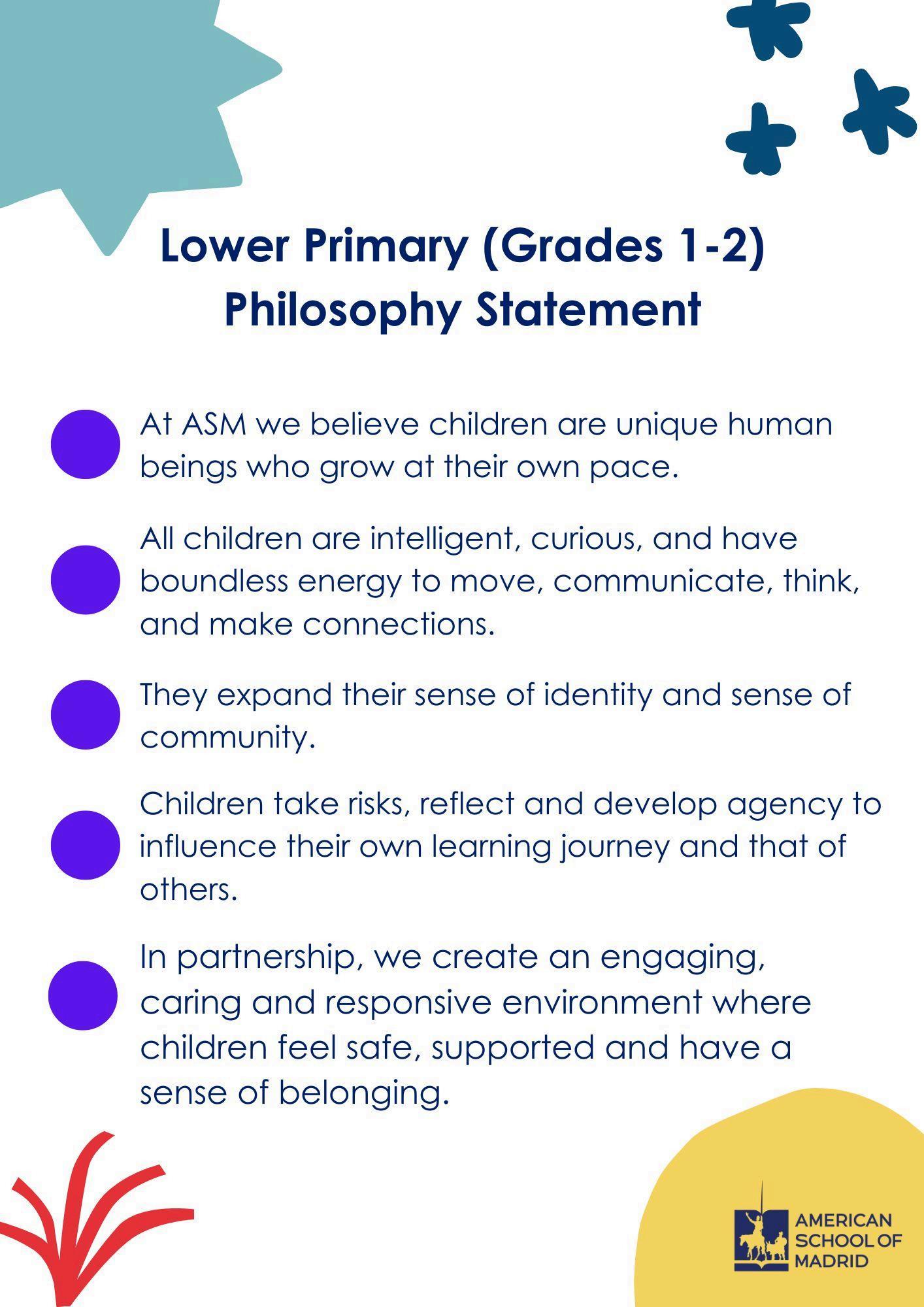
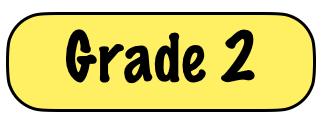
Most 7-year-olds display an unending thirst for knowledge and will have an innate curiosity and excitement about things in the world They are natural explorers, scientists, and analysts, and often ask questions about everything from why the sky is blue to where babies come from. At this age, they also take great pride in sharing their knowledge about things and often enjoy showing younger children skills that they themselves have mastered For a 7-year-old, there will be a sense of confidence at school that comes from being familiar with the ins and outs of being a student in the classroom. They will often feel a sense of pride in having achieved basic math and reading skills and may want to discuss what they learned in school with parents, friends, and caregivers (VeryWellFamily, 2019 )
Click for the full article: Including physical, emotional, and cognitive development. 7-Year-Old Child Development Milestones
The work of all teachers is to meet each child where he or she is and then to move that child forward Teachers are continually assessing student progress within the curriculum as evidenced by classroom-based and common grade-level assessments. These assessment types identify learner progress in relation to themselves and where they started, to our curriculum and standards, as well as to the ASM class and grade-level group
Additionally, we gauge student progress using externally-developed, globally-recognized, and normed metrics of measurement twice a year We compare a child’s progress in the classroom with these externally-designed assessment targets. If the results of a student's growth show significant discrepancies between these multiple types of assessments, teachers will conduct additional assessments and begin a differentiation plan, as needed Continued concerns about progress will result in the student being referred to our Learners Support and/or EAL teachers for support.
ASM operates under a Multi-Tiered System of Support. Our intention is that our teaching resources support differentiated instruction for the range of learners we find in every classroom We use consistent progress monitoring to inform our teaching and thereby determine the level of support or enrichment our students may need at a given point in time. Based on data-informed progress monitoring, classroom teachers differentiate curricula to engage various types of learners and learning styles.
The ASM Lower School also has a Coordination of Support Team (COST) that includes Counselors, Learning Support teachers, English Language development teachers, and Administration. This
team reviews data and student progress with grade-level teams. When determined necessary, the COST team collaborates with teaching teams to design responsive intervention plans with academic, behavioral, social emotional or English language development goals for students.
The ELD program in the Lower School provides support services to multilingual learners from Grade 1 to Grade 5 by supporting students to develop their English language skills and access academic learning. Students are assessed in the fall and/or spring to measure their progress toward English proficiency in oral, reading, and written skills
Students entering ASM who speak a language other than English as a primary home and/or academic language will be assessed using the World-Class Instructional Design and Assessment (WIDA) assessments within two weeks of starting school. Depending on their score and teacher input, the student may receive English language support and have their growth measured through annual/biannual WIDA assessment As a student reaches a level of English proficiency that facilitates their independent learning at ASM, they will no longer take WIDA English assessment.
School Counselors collaborate with classroom teachers and staff in order to create and maintain an environment that encourages both academic and social-emotional learning They promote developmentally appropriate student behavior for classroom management and school-wide expectations.
They engage in ongoing consultation with students, teachers, parents, and ASM’s administration to address student learning differences, social-emotional development, emotional literacy, and behavioral functioning in order to meet individual student needs
They deliver standards-based classroom lessons to all students as part of a comprehensive counseling program Counselors also deliver individual and group school counseling to students who may need more support regarding their social and emotional health and well-being. They are also generally the first to respond and provide support to students who are in emotional crises and child protection-related situations
Additionally, the counselors participate in orientation and departure programs for Lower School students and their families in order to support students’ transition and adjustment
Practicing skills learned in class, extension or application of concepts already learned, as well as integration of a variety of skills in a single assignment or project, are among the
purposes for homework at ASM. Homework also helps students develop good study habits and learn how to manage their time and materials.
That said, research shows that homework does not necessarily contribute to increased learning. Therefore, our goal is to provide students with homework while also ensuring that they have time for extracurricular activities, to play outside, and to be with their family and friends The vast majority of learning will take place inside the classroom with other students and your child’s teacher.
The time it takes each child to complete work varies Our intention is that most students will spend an average of 10 minutes per grade on homework each night:
1- 10 minutes
2- 20 minutes
3- 30 minutes
4- 40 minutes
5- 50 minutes
*Students in the Native Spanish Program will receive more homework due to the added requirements of this program. If parents feel their child’s homework is excessive, they should contact the teacher.
These guidelines for homework time include time to read independently. All LS students from Kinder 3 to Grade 5 are expected to read every night for 5 to 30 minutes depending on their age Developing an independent reading habit is extremely important Independent reading should be reading that is relatively easy. ‘Just right’ books are books children can read on their own quickly and smoothly.
To ensure that all students have the opportunity to review and practice or advance on skills important to their growth, all students in Grades 1-5 engage in WIN Time for 50 minutes every 6 days. This period occurs at a set time each week in the grade-level schedule and instruction is provided by the classroom teachers, Spanish teachers, and COST team The large number of adults involved in WIN time ensures small groups of children can work on specific, targeted skills necessary for their growth and development in the academic areas of math, reading, writing, and Spanish Students are flexibly grouped based on the most important opportunity for growth
In the Lower School, we make learning come alive by connecting to the local community and engaging in real-life learning. Each year field trip opportunities are designed by teachers to ensure the curriculum is enhanced and students’ current interests (and available opportunities within the community) are considered.
It is important for students to be on time to school to attend a field trip Coordination of late-arriving students requires involvement from the Lower School Director and the grade-level team leader. In some cases, if a child is tardy to school, joining the field trip late will not be an option
In the Lower School, student growth is communicated via a process that ensures parents are aware of growth and development every day
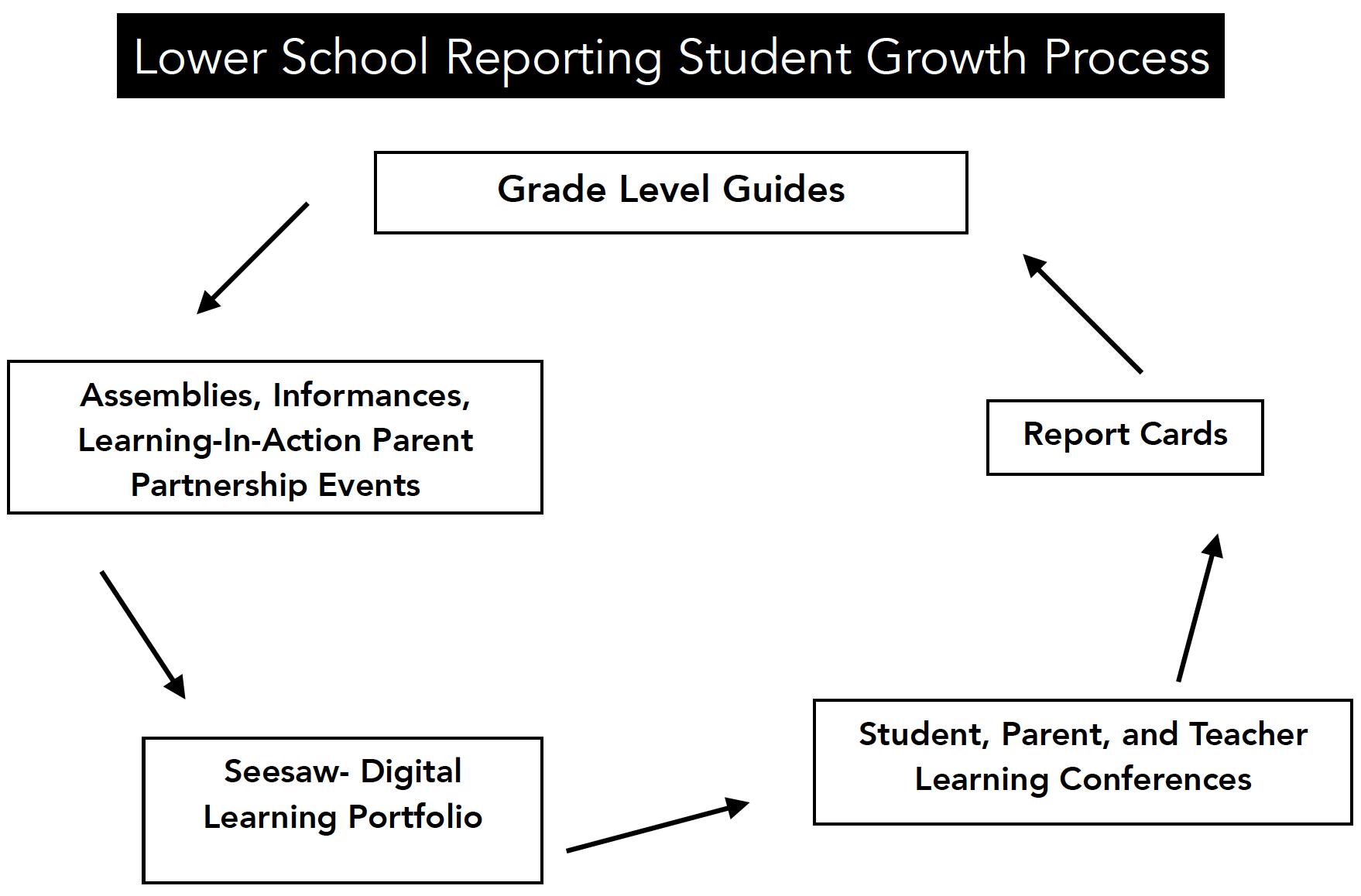
Throughout the year parents will be invited on campus to participate in their child’s learning life. These opportunities will be a mixture of celebrations, presentations, learning engagements, and the opportunity to see classrooms in action.
Students and teachers use Seesaw as a digital portfolio to celebrate and document student learning and to strengthen the home and school connection for our families Students will use Seesaw to share their creativity, show their understanding, build technological skills, develop pride in their work, and reflect on their learning. In addition, teachers will share regular announcements to parents via email through weekly newsletters.
Two times per year, students, parents, and teachers meet to celebrate and discuss student goals, progress, and next steps.
Grade Level Guides provide detailed information about the overall program at the grade level including what students are expected to learn and be able to do during the year
Three times per year, student growth is summarized and shared with families via our Lower School report card This report card represents students' performance in relation to standards, benchmarks, and widely held developmental expectations.
ASM believes that in order to be successful in and out of school, students need to learn a set of social and emotional competencies cooperation, assertiveness, responsibility, empathy, and self-control and a set of academic competencies academic mindset, perseverance, learning strategies, and academic behaviors To live this belief, the Lower School utilizes a student-centered, social, and emotional learning approach to teaching and discipline. The principles that guide this approach are:
1. Teaching social and emotional skills is as important as teaching academic content.
2. How we teach is as important as what we teach.
3 Great cognitive growth occurs through social interaction
4. How we work together as adults to create a safe, joyful, and inclusive school environment is as important as our individual contribution or competence
5. What we know and believe about our students individually, culturally, and developmentally informs our expectations, reactions, and attitudes about those students
6 Partnering with families knowing them and valuing their contributions is as important as knowing the children we teach
Children in the Lower School are guaranteed a high-quality play experience. In fact, we believe that the time spent playing is just as important as the time spent learning inside the classroom setting Play provides opportunities for children to develop skills in physical activity, socialization, cooperation, coordination, resilience, creativity, and imagination. Of course, it is also the most enjoyable part of a child’s day!
The ASM Play Landscape, consisting of Don Quijote Park, Sancho Panza playground, and the Lower Field is different from a regular playground. Our students have 100s of items to play with (in a fantastic natural setting) rather than simply a playground with a few items to play upon
Our OPAL program is grounded in the theory of loose parts which states that “it’s the loose parts in our environment that empower our creativity. Loose parts are materials with no specific set of directions that can be used alone or combined with other materials, therefore can be used in any way that children choose and can be adapted and manipulated in many ways. Loose parts can be natural or synthetic. Loose parts are materials that can be moved, carried, combined, redesigned, lined up, and taken apart and put back together in multiple ways ”1
Staff at ASM are trained by OPAL (Outdoor Play and Learning) to offer high-quality play experiences for children
Play is not what we do after learning. OPAL is learning time!
At ASM we believe that play is a process that is:
1. Freely chosen by the child
2. Directed by the child
3 For the child’s own motivations and reasons
4 Offered and available in all weather conditions
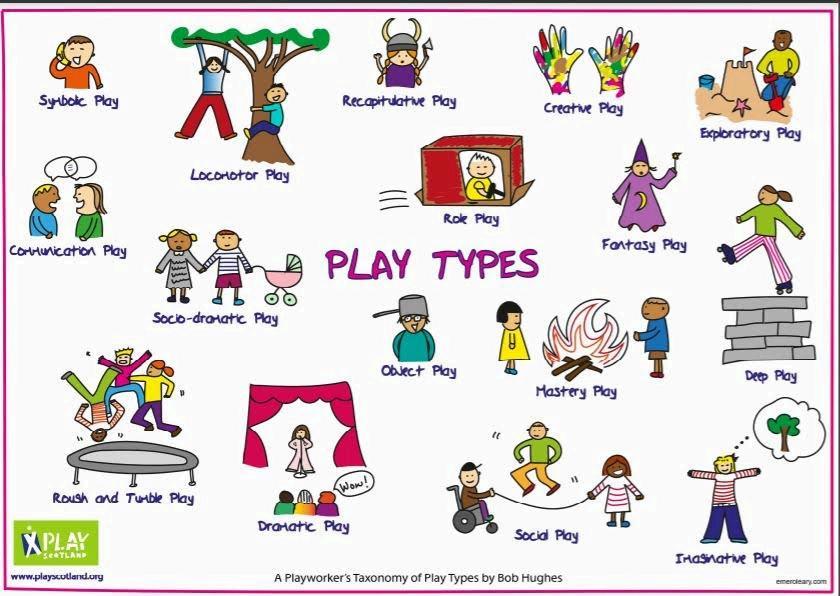
Children in ASM’s primary years learn the foundations of emergent literacy through authentic and meaningful reading, writing, and word study experiences aimed at increasing independence and agency Our learners develop literacy skills, strategies, and competencies at ASM in order to master the globally recognized expectations outlined in the Common Core State Standards. The English literacy teaching and learning experiences of ASM are designed to prepare students for life outside the classroom and are directed not only by the above-mentioned standards but by student interests and needs as well.
ASM utilizes a balanced literacy workshop approach when teaching English Language Arts which looks like rich language and print-based learning opportunities across the school day: read-aloud, reading and writing workshops with independent practice, explicit and systematic phonics/word study instruction, interactive writing, shared reading and writing, and guided reading instruction.
1 PlayWales.org, Sept. 2020
This research-based approach allows teachers to identify where each learner is on the continuum of literacy development and then match learning experiences to their individual areas of focus in whole and small group settings, as well as in peer partnerships and one-on-one teacher/student supports.
Domain Strand
Reading Foundational Skills
Areas of Focus and Development
Develop Phonics and Word Recognition, and Read with Sufficient Accuracy and Fluency to Support Comprehension
Literature Ask and Answer Questions about Key Ideas and Details, Recount Stories, Describe How Characters Respond in Stories, Describe Craft and Structure of Stories, Gather Knowledge and Generate Ideas, Compare and Contrast, and Actively engage in reading activities with purpose and understanding of Literature / Narrative Texts
Informational Text
Writing Text Types and Purposes
Production and Distribution of Writing
Research to Build and Present Knowledge
Ask and Answer Questions about Key Ideas and Details, Identify Main Topic, Describe Connections, Know and Use Text Features, Gather Knowledge and Generate Ideas, Compare and Contrast, and Actively engage in reading activities with purpose and understanding of Informational / Nonfiction Texts
Compose narrative (recounting a well-elaborated event or sequence of events), informational (introducing a topic, teaching facts), and opinion (stating an opinion, supplying reasons) pieces across the year
With guidance and support from adults, respond to questions and suggestions from peers and explore a variety of digital tools and publish writing
Participate in shared research and writing projects, and recall information from experiences or gather information.
Range of Writing (beginning in Grade 3)
Speaking and Listening
Comprehension and Collaboration
Presentation of Knowledge and Ideas
Language Conventions of Standard English
Knowledge of Language
Vocabulary Acquisition and Use
Develop understanding through conversations about second-grade topics and texts, ask and answer questions, seek help, and get information through collaboration with adults and peers Recount and describe key ideas from a text read aloud or presented orally / through other media
Describe, draw, speak, and express thoughts, feelings and ideas. Produce complete sentences when appropriate to the task and situation Produce complete sentences when appropriate to the task and situation.
Demonstrate command of the conventions of standard English grammar & usage when writing or speaking (use collective nouns, form and use irregular plural nouns, use inflexive pronouns, irregular verbs, adjectives, and adverbs) capitalize, punctuate, & use conventional spelling for words with common patterns, & consult reference materials to check and correct spelling
Use knowledge of language and its conventions when writing, speaking, reading, or listening.
Explore word relationships and determine or clarify the meaning of unknown and multiple-meaning words at a second-grade level Develop, express, and expand upon ideas in response to reading in writing or orally.
Children in ASM’s lower school develop their mathematical understandings, skills, and practices through a constructivist math workshop approach which prioritizes a large block of time for differentiation to match instruction to students’ abilities
ASM’s math program aims for all students to master globally recognized content standards as well as mathematical practice standards
Our approach to math teaching and learning is supported by the utilization of core curricular resources, one of which is Everyday Mathematics.
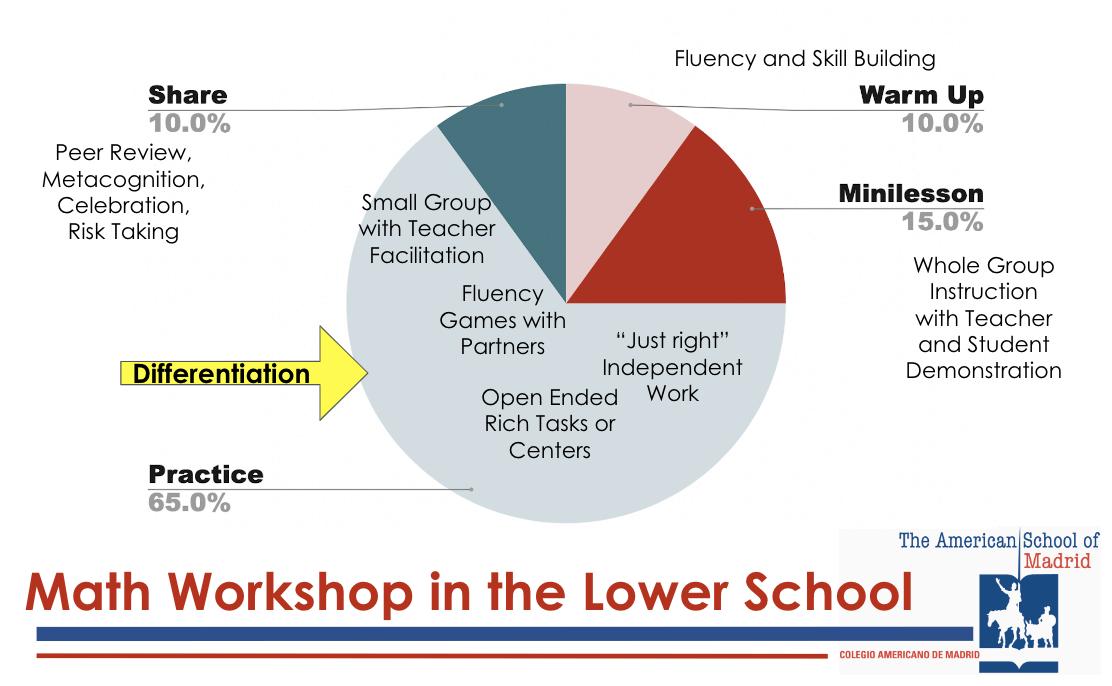

Domain
Operations and Algebraic Thinking
Numbers and Operations in Base Ten
Measurement and Data
Geometry
Mathematical Practices and Real World Applications
Areas of Focus and Development
Represents and solves addition and subtraction problems
Adds and subtracts within 20
Works with equal groups to form foundations for multiplication
Understands place value Uses place value when understanding properties
Measures and estimates lengths in standard units
Relates addition and subtraction to length
Represents and interprets data
Reasons with shapes and their attributes
Makes sense of problems and perseveres in solving them
Clearly communicates mathematical thinking
Models with mathematics
Clearly constructs arguments and critiques the reasoning of others
Teachers teach conceptual-based units which are organized around a concept. This approach integrates various subjects such as science, reading, writing, social studies, etc and all are connected by a common theme The goal is to provide a more engaging learning experience for students and help them gain a deeper understanding of the concept and how it applies across different subjects. In Grade 2, the students may explore concepts such as belonging, relationships, legacies, and changes
ASM uses the Next Generation Science Standards and the C3 Standards as a basis to engage students in learning through inquiry around science and social studies. During the year, students may explore physical science, life science, earth and space science, engineering design, civics, economics, history, and geography
At ASM in the Lower School all students in K1- Grade 5 benefit from learning Spanish
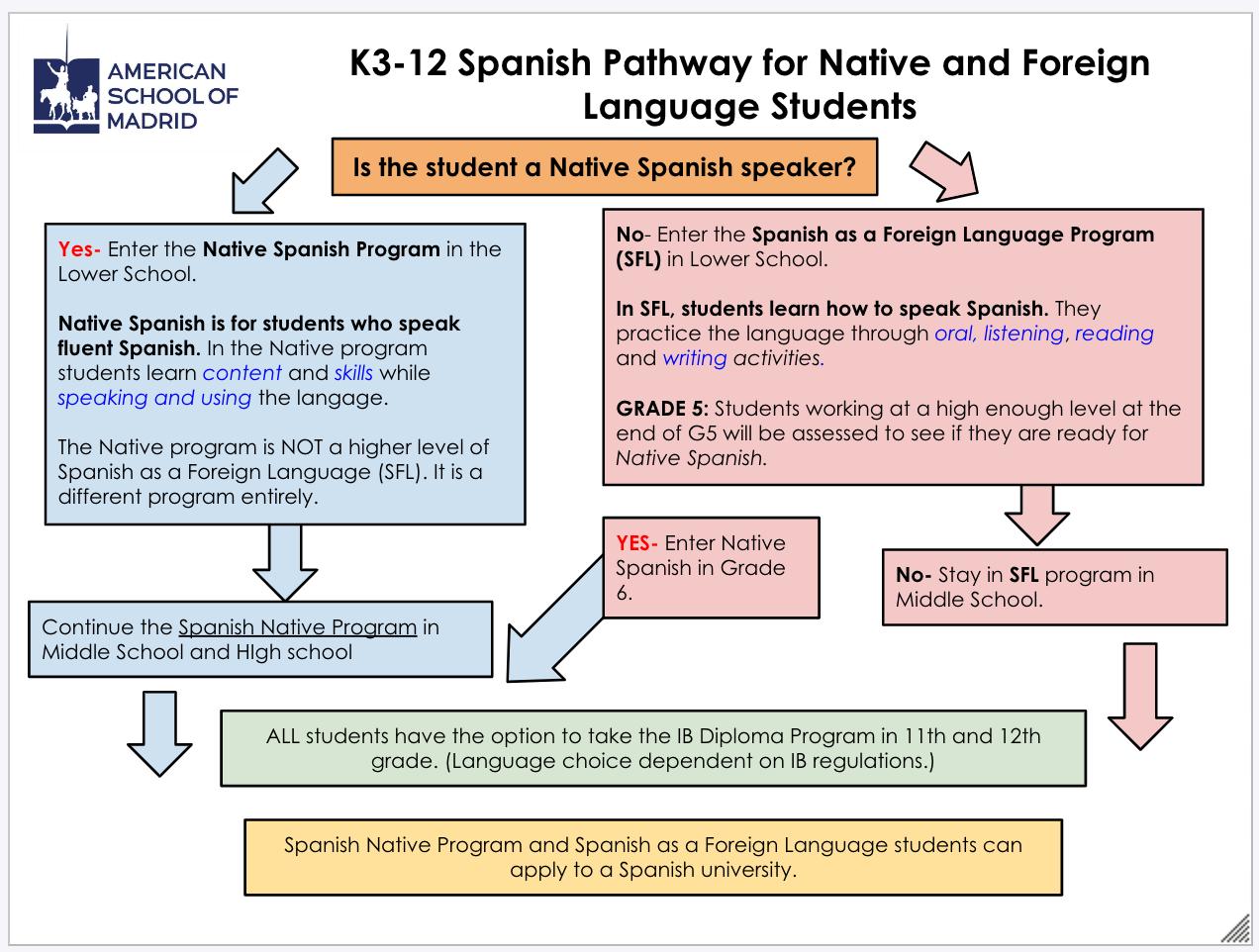
At ASM in the Lower School, the Native Spanish program is for native speakers who speak Spanish as a mother tongue at home. The program follows the curriculum established by the Spanish Ministry of Education Students in this program express themselves in an appropriate manner in a variety of situations both linguistically and culturally. Students learn both Spanish language and culture through social studies
The Native Spanish program includes:
● A native Spanish teacher
● Curriculum mandated by the Ministry of Education
Domain Students will be able to
Oral Communication: speaking and listening
Reading Comprehension of Short Texts
Written Comprehension: Writing
Ask adequate questions to obtain information or to check the significance of expressions or words that you don’t understand
Describe objects, people, animals, places, and scenes in the world that are real or fiction
Read short texts aloud with pronunciation, fluency, and adequate rhythm while respecting the punctuation signs
Read a text silently figuring out unknown words in the text and explaining the content orally
Write texts about announcements, posters, comics, and jokes with an intent to inform, narrate, describe, and encourage
Knowledge of the language Know synonyms and antonyms of given words and use them correctly
At ASM in the Lower School, the Spanish as a Foreign Language program is for all students in the lower school who are not native Spanish speakers
The main objective of this program is to introduce students to the Spanish culture and enable them to achieve a level at which they will be able to participate in everyday activities using the Spanish language with sufficient fluency and accuracy.
The Spanish as a Foreign Language program includes:
● A trained Spanish teacher
● Units designed to engage students in conversations about everyday life. The following topics will be covered throughout the year: school, family, nature, the country of Spain, and its celebrations/traditions.
● Students learn through role-plays, games, songs, stories, and creative work
● Several levels which allow students to continue to progress in their language learning and development
I can use basic greetings
I can present myself, name, age, where I am from, who my friends are
I can ask others about themselves
I can state my likes
I can express my basic needs
I can say when I don’t understand and ask how you say something in Spanish
I can ask questions and make statements about the topics we are studying in my classroom
I can understand everyday expressions and questions dealing with simple and concrete everyday needs and follow speech
I can understand questions and instructions in the classroom and show that I understand by answering and following short, simple directions
I can understand vocabulary for colors, days of the week and months, numbers and dates
I can understand the names for familiar objects and classroom vocabulary
I can understand the names and vocabulary for the calendar
I can understand words, phrases and traditions associated with different holidays and festivals celebrated during the school year
I can understand and answer questions about very general ideas about what we have read
I can read the familiar names, words, simple phrases, and instructions on the classroom board and cards we have in the classroom
I can independently read very short simple texts, putting together familiar names, words, and basic phrases
I can independently and fluently read and comprehend books at the expected level for A1 at my grade
I can write my name, the date, and any other information requested by my teacher on my school papers
I can write a simple sentence about my weekend
I can use basic greetings
I can present myself, name, age, where I am from, who my friends are
I can ask others about themselves
I can state my likes
I can express my basic needs
I can say when I don’t understand and ask how you say something in Spanish
I can ask questions and make statements about the topics we are studying in my classroom
I can write my name, the date, and any other information requested by my teacher on my school papers
I can write a simple sentence about myself
I can correctly write many of the vocabulary words we have studied in each unit, for example, fall and family if developmentally appropriate
I can write simple phrases and sentences to answer questions about a simple story we have read or a holiday we have studied
I can understand everyday expressions and questions dealing with simple and concrete everyday needs and follow speech
I can understand questions and instructions in the classroom and show that I understand by answering and following short, simple directions
I can understand vocabulary for colors, days of the week and months, numbers, and dates
I can understand simple class songs and poems
I can understand the names of familiar objects and classroom vocabulary
I can understand the names of familiar objects, people, food, clothing, and animals presented in our lessons
I can understand words, phrases, and traditions associated with different holidays and festivals celebrated during the school year
I can read the familiar names, words, simple phrases and instructions on the classroom charts and cards we have in the classroom
I can independently read very short simple texts, putting together familiar names, words and basic phrases
I can independently and fluently read and comprehend books at the expected level for A1 at my grade
I can understand and answer basic questions about very general ideas about what we have read
I can ask somebody to repeat and clarify what they said
I can describe my hobbies and interests in a simple way using complete sentences.
I can give short basic descriptions and describe past and future activities and personal experiences (Last weekend….I On my last holiday….. Next week I am going to….
I can have a conversation with my peers
I can summarize a book and identify the main ideas
I can understand enough to manage simple, sustained, routine conversations without too much effort.
I can catch the main point in short, clear simple messages, directions, and announcements given by my teacher.
I can understand the language used in places like homes, shops, restaurants, or travel situations that I might hear in videos or during role-playing situations.
I can identify the main points of videos and presentations
I can understand the events spoken in the past tense.
I can understand and answer questions about very general ideas about what we have read
I can read the familiar names, words, simple phrases, and instructions on the classroom charts and cards we have in the classroom
I can independently read very short simple texts, putting together familiar names, words, and basic phrases
I can independently and fluently read and comprehend books at the expected level for A1 at my grade
I can write explanations about what I like or dislike about something.
I can write short, basic descriptions of events and activities using the present tense.
I can use the past tense to describe personal experiences about my life (weekends, holidays etc)
The visual arts are an integral part of everyday life, permeating all levels of human creativity, expression, communication, and understanding. They range from traditional forms embedded in local and wider communities, societies, and cultures, to the varied and divergent practices associated with new, emerging, and contemporary forms of visual language.
In the Lower School, we celebrate the visual arts not only in the way we create images and objects, but also in the way we appreciate, enjoy, respect, and respond to the practices of art-making by others from around the world.
Theories and practices in visual arts are dynamic and ever-changing, and connect many areas of knowledge and human experience through individual and collaborative exploration, creative production, and critical interpretation.
Students in Grade 2 receive 100 minutes of Art instruction every six days This includes creating art, learning about real artists, and responding to artworks both created by professional artists as well as those created in our classrooms with other musicians At ASM, visual art teaching and learning is based on the National Core Art Standards.
Frequently, teachers and students will post information about visual art learning on Seesaw At various times throughout the year, parents are invited to art shows where students showcase their learning.
Domain
Students will be able to
Creating Brainstorm various approaches to an art or design project with others
Experiment with different tools and media
Use art supplies and tools safely and clean the workspace
Presenting
Responding
Connecting
Group artwork based on a theme or concept
Choose the best way to display artwork
Explain the artistic process using art vocabulary
Perceive art in the world around them
Discuss artwork based on subject matter and mood
Use art vocabulary to explain their feelings about a work of art
Create artwork about events in their lives
Compare and contrast artwork from different times and places
Make personal connections to the artwork
Music is a fundamental form of both personal and cultural expression. It allows us to express our feelings and ideas about ourselves and our place in the world. Through music, students can appreciate and understand aspects of their own culture as well as the culture of others
Students in Grade 2 receive 100 minutes of Music instruction every six days This includes time singing, playing instruments, composing melodies, learning dances, and collaborating with other musicians. At ASM, music teaching and learning is based on the National Core Art Standards. In Grade 2 students continue to develop appropriate singing techniques, perform together in an ensemble of pitched and unpitched percussion, begin reading and writing rhythm notation, evaluation and analysis of musical works, and expanding their musical vocabulary
By utilizing the whole child approach, students are given the skills of mindfulness to implement breathing and controlled poses to help them focus on self-awareness and the impact of their emotions.
Frequently, teachers and students will post information about music learning on Seesaw. At various times throughout the year, parents are invited to participate in music “informances” which allow students to showcase their learning in authentic ways. In addition, more formal performances are part of the curriculum.
Domain
Students will be able to
Creating Develop skills through performance, notation, exploring, imitating, and recognizing elements of music. Mastery is demonstrated by using the voice, varied pitched and unpitched percussion instruments, and movement
Improvise rhythmic and melodic patterns and musical ideas for a specific purpose
Create melodies and perform music to communicate ideas to an audience
Interpret and apply personal, peer, and teacher feedback to revise personally-created music
Performing Celebrate musical understanding with the school community and parents on regular occasions by using the voice, instruments, and movement
Responding
Connecting
Demonstrate knowledge of musical concepts and how they influence performers or listeners of music
Apply personal and expressive preferences to evaluate music
Demonstrate knowledge of music concepts (such as tonality and meter) in music from a variety of cultures selected for performance
Demonstrate how interests, knowledge, and skills relate to personal choices and intent when creating, performing, and responding to music
Demonstrate understanding of relationships between music and the other arts, other disciplines, varied contexts, and daily life.
At the American School of Madrid, Physical Education and Health is both an integral and essential part of the total educational program. PE supports the development of a child’s physical, social, and mental well-being both inside and outside the classroom.
Students in G1-G5 receive 100 minutes of PE instruction every six days This includes time engaged in physical activities and discussing age-appropriate concepts related to PE and Health.
We believe that offering a wide range of diverse activities paired with the discussion of concepts related to both PE and Health empowers each student to embrace life-long activity and wellness in a way that is effective and meaningful for them. At ASM the curriculum is derived from the Ontario Health and Physical Education curriculum.
Frequently, teachers and students will post information about PE learning on Seesaw. During the year parents are invited to PE-hosted events where students showcase and celebrate what they have learned in PE.
Domain Students will be able to
Social and emotional learning skills
Active living
Movement competence
Healthy living
Resolve conflicts
Identify and manage emotions
Cope with challenging situations
Develop and maintain healthy habits and caring relationships
Practice respectful behaviors and develop responsibility
Create positive habits relating to daily and lifelong physical activity
Demonstrate personal safety and injury prevention
Recognize the value of physical activity for health, enjoyment, challenge, self-expression, and or social interaction
Develop locomotor and manipulative skills
Understand and apply concepts, strategies, and tactics related to games and movement
Understand and make positive choices regarding physical health, mental health, and the well-being of others.
ASM uses the ISTE Standards to guide technology integration across subjects and in the daily lives of students to enhance learning The main objective of our technology integration is to enhance student learning and empower students to innovate and problem-solve. Students have access to 1:1 devices and a Promethean board. Students may explore technology applications such as Google Suite and digital books.
The LS Learning Commons space and program serve to foster and develop a love of reading and give our students access to information and ideas, helping them to become critical thinkers,
global citizens, and life-long learners. The Learning Common’s collection is developed by the librarian to support ASM’s curricula as well as the intellectual growth, personal development, individual interests, and recreational needs of all our students Instruction by the librarian, in collaboration with classroom teachers, follows the American Association of School Librarians Standards Framework for Learners.
Grade 2 students come once every six days with their classroom teacher to select books for personal reading. At the start of the year, students check out two books per visit although this limit can be flexible and will progress depending on student needs (school holidays, special projects, etc )
Research/Inquiry Instruction
In collaboration with classroom teachers, the librarian supports students in further developing research skills and information literacy with print materials and curated online resources. In Grade 2 this mainly occurs during the ELA Writing unit: Research to Build and Present Knowledge and in the Social Studies units.

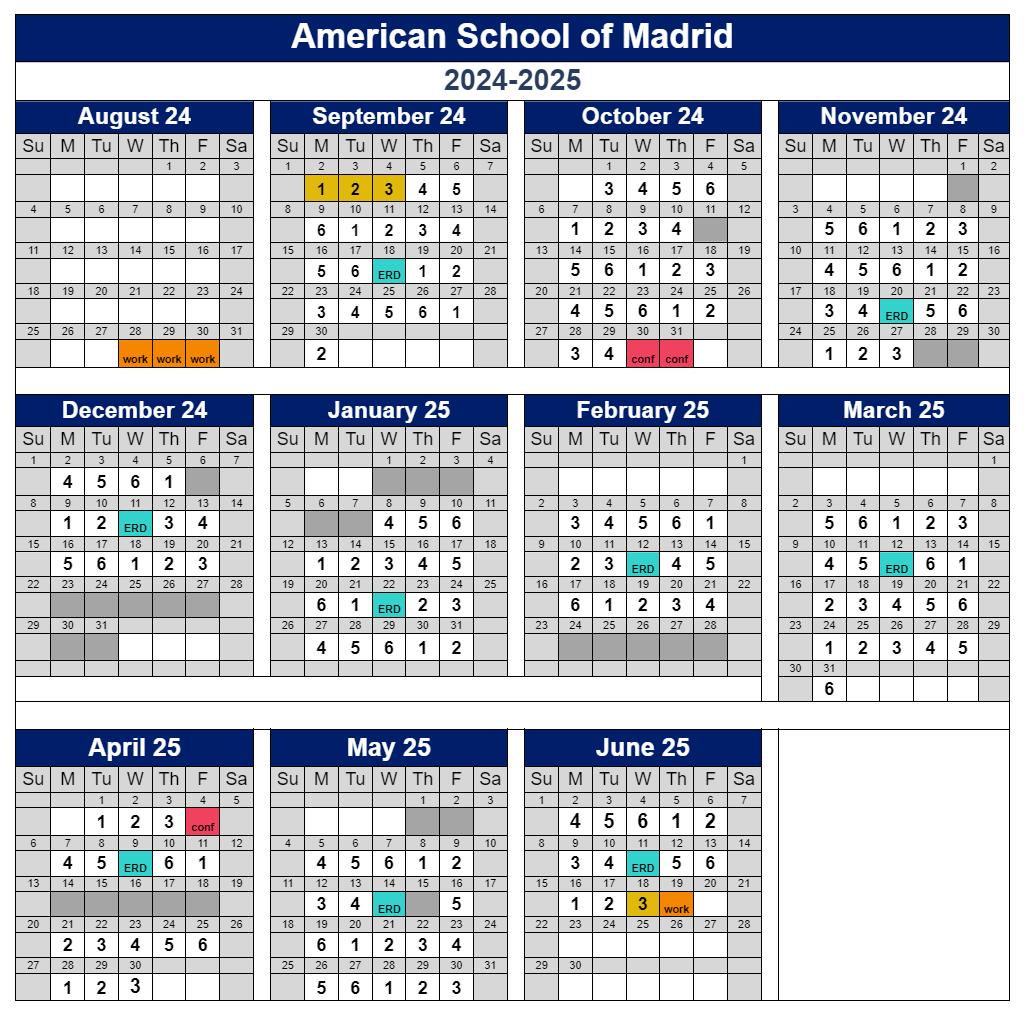
The American School of Madrid does not discriminate on the basis of race, color, gender identity,sexual orientation, national origin, religion, or marital status.